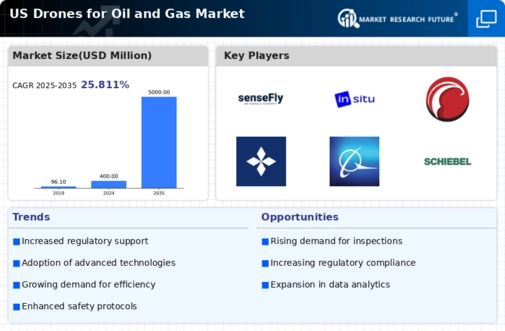Cost Efficiency and Operational Savings
Cost efficiency remains a pivotal driver in the drones for-oil-gas market. The deployment of drones can significantly reduce operational costs associated with traditional inspection methods, such as manned aircraft or ground crews. For example, using drones for pipeline inspections can lower costs by approximately 30%, as they require less manpower and can cover larger areas in shorter timeframes. Additionally, drones minimize the need for scaffolding and other equipment, further reducing expenses. As oil and gas companies face fluctuating prices and tighter margins, the potential for substantial cost savings through drone technology becomes increasingly attractive. This economic incentive is likely to propel the growth of the drones for-oil-gas market as companies seek to enhance their bottom line.
Growing Demand for Environmental Monitoring
Environmental concerns are increasingly influencing the drones for-oil-gas market. Companies are under pressure to monitor their environmental impact, and drones provide an efficient solution for this task. Equipped with sensors, drones can conduct aerial surveys to assess land use, monitor emissions, and track wildlife impacts. The ability to gather data quickly and accurately allows companies to comply with environmental regulations and improve their sustainability practices. In fact, the market for environmental monitoring drones is projected to grow by 15% annually, reflecting the increasing importance of environmental stewardship in the oil and gas sector. This growing demand for environmental monitoring is likely to drive the adoption of drones, as companies strive to enhance their corporate responsibility.
Regulatory Developments Favoring Drone Usage
Regulatory developments are playing a crucial role in shaping the drones for-oil-gas market. Recent changes in legislation have streamlined the approval processes for drone operations, making it easier for companies to integrate this technology into their workflows. The Federal Aviation Administration (FAA) has introduced new rules that facilitate the use of drones for commercial purposes, including inspections and monitoring. These regulatory advancements not only enhance operational efficiency but also encourage investment in drone technology. As compliance becomes less cumbersome, more companies are likely to adopt drones, thereby expanding the market. The favorable regulatory environment suggests a promising trajectory for the drones for-oil-gas market, as it aligns with industry needs for innovation and efficiency.
Increased Focus on Safety and Risk Management
Safety and risk management are paramount in the oil and gas industry, and drones are emerging as a vital tool in enhancing these aspects. The ability to conduct inspections in hazardous environments without putting personnel at risk is a significant advantage. Drones can access hard-to-reach areas, such as offshore platforms or remote pipelines, allowing for thorough inspections without exposing workers to danger. This capability not only improves safety but also aids in risk management by identifying potential issues before they escalate. As safety regulations become more stringent, the reliance on drones for inspections and monitoring is likely to increase. This heightened focus on safety is expected to drive the growth of the drones for-oil-gas market, as companies prioritize the well-being of their workforce.
Technological Advancements in Drone Capabilities
The drones for-oil-gas market is experiencing a surge in technological advancements, particularly in drone capabilities. Innovations such as improved battery life, enhanced imaging systems, and advanced navigation technologies are driving this growth. For instance, drones equipped with thermal imaging can detect leaks in pipelines, which is crucial for maintaining safety and efficiency. The integration of AI and machine learning into drone operations allows for real-time data analysis, which can lead to more informed decision-making. As these technologies continue to evolve, the operational efficiency of oil and gas companies is likely to improve, potentially reducing costs by up to 20%. This trend indicates a robust future for the drones for-oil-gas market, as companies seek to leverage these advancements to optimize their operations.

















Leave a Comment